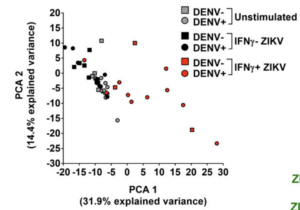
Grifoni et al., 2018 Figure 1A: Gene expression analysis of ZIKV-specific CD8+ T cells. PCA of unstimulated IFN-γ- (gray) and ZIKV-stimulated IFN-γ- (black) and IFN-γ+ (red). DENV pre-exposed (circles) and DENV naive (square) are also shown (Source Grifoni et al., 2018)
Zika virus (ZIKV) disease is an emerging public health problem with no available treatment nor vaccine. Emergence of zika virus diseases in Central and South America, has sparked renewed interest in the epidemiology, pathogenesis and immune kinetics of the disease.
Vaccines rely on the induction of adaptive T and B cells responses to confer long term immunity. A potential challenge to inducing protective ZIKV immunity by vaccination, is pre-existing dengue virus (DENV) immunity. Both ZIKV and DENV are transmitted by Aedes aegypti mosquito, thus it is not surprising that they occur in the same geographical. DENV-specific immunity has been shown to be cross-reactive to ZIKV. Additionally, individuals with pre-exisiting DENV-immunity have been shown to have increased ZIKV-specific de novo immunity, that are skewed towards non-structural proteins.
CD8 T cells responses induced by ZIKV, have been suggested to play a crucial role in protective ZIKV-immunity. Study by Grifoni et al., conducted an in-depth functional phenotyping study of CD8 T cells in individuals with convalescent or previous zika infection. Interestingly, when they compared transcriptional profiles of individuals based on previous DENV exposure, they did not observe a difference. This suggests that DENV pre-exposure may only affect CD8 T cell immunity during the acute phase of ZIKV infection, and not once ZIKV is cleared.
Grifoni et al., observed differential gene expression profiles between ZIKV-specific CD8+ T cells (defined by IFNg expression) and bulk CD8 T cell responses. Transcriptional differences were predominantly the up-regulation of functional features such as cellular activation (4-1BB, CD69), cytotoxic capacity (Granzyme B, CRTAM*) and inflammatory chemokines (CCL3, CCL4). Finally, they showed that ZIKV-specific CD8 T cells activation and cytotoxic capacity that were unregulated during convalescence are sustained 1-2years post ZIKV infection.
This study highlights the need to understand immune kinetics during acute, chronic, convalescent and long-term previously ZIKV-exposed individuals. Results from such studies may complement the design of an effective ZIKV-vaccine that is capable of inducing robust immunity and different stages of ZIKV infection.
*CRTAM: Cytotoxic and regulatory T cell molecule (CRTAM)
Journal Article: Grifoni et al., 2018. Cutting Edge: Transcriptional Profiling Reveals Multifunctional and Cytotoxic Antiviral Responses of Zika Virus−Specific CD8 + T Cells. Journal of Immunology.
Article by Cheleka AM Mpande











